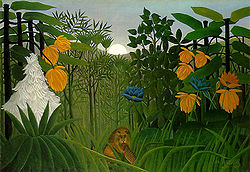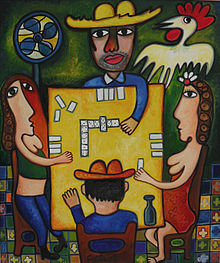- Naïve art
-
For the Red Flag album, see Naïve Art (album).
 Henri Rousseau's The Repast of the Lion (circa 1907), an example of naïve art
Henri Rousseau's The Repast of the Lion (circa 1907), an example of naïve art
Naïve art is a classification of art that is often characterized by a childlike simplicity in its subject matter and technique. While many naïve artists appear, from their works, to have little or no formal art training, this is often not true. The words "naïve" and "primitive" are regarded as pejoratives and are, therefore, avoided by many.[1]
Contents
Characteristics
The term naïve art[2] is often seen as outsider art which is without a formal (or little) training or degree. While this was true before the twentieth century, there are now academies for naïve art. Naïve art is now a fully recognized art genre, represented in art galleries worldwide.
The characteristics of naïve art are an awkward relationship to the formal qualities of painting. Especially non-respect of the 3 rules of the perspective (such as defined by the Progressive Painters of the Renaissance) :
- 1° decrease of the size of objects proportionally at the distance,
- 2° enfeeblement of colors with the distance,
- 3° decrease of the precision of details with the distance,
The results are :
- 1° effects of perspective geometrically erroneous (awkward aspect of the works, children's drawings look, or Middle Ages' painting look, but the comparison stops there)
- 2° strong use of pattern, unrefined color on all the plans of the composition, without enfeeblement in the background,
- 3° an equal accuracy brought to details, including those of the background which should be shaded off.
Simplicity rather than subtlety are all supposed markers of naïve art. It has, however, become such a popular and recognizable style that many examples could be called pseudo-naïve.
Whereas naïve art ideally describes the work of an artist who did not receive formal education in an art school or academy, for example Henri Rousseau or Alfred Wallis, 'pseudo naïve' or 'faux naïve' art describes the work of an artist working in a more imitative or self-conscious mode and whose work can be seen as more imitative than original.
"Primitive art" is another term often applied to art by those without formal training, but is historically more often applied to work from certain cultures that have been judged socially or technologically "primitive" by Western academia, such as Native American, subsaharan African or Pacific Island art (see Tribal art). This is distinguished from the self-conscious, "primitive" inspired movement primitivism. Another term related to (but not completely synonymous with) naïve art is folk art.
There also exist the terms "naïvism" and "primitivism" which are usually applied to professional painters working in the style of naïve art (like Paul Gaugin, Mikhail Larionov, Paul Klee, Sergey Zagraevsky etc.).[3]
Naïve artists
18th century
 Example of Niko Pirosmani's work: Childless Millionaire and a Poor Woman Blessed with Children.
Example of Niko Pirosmani's work: Childless Millionaire and a Poor Woman Blessed with Children.
- Edward Hicks (1780–1849)
- Oluf Braren (1787–1839)
- Justus DaLee (1793–1878)
19th century
- Peter Rindisbacher (1806–1834) American, b. Switzerland
- James Bard (1815–1897)[4]
- Denys Corbet (1826–1910)
- Nikola Obrasopissez (1827–1911)
- Ferdinand Cheval, known as 'le facteur Cheval' (1836–1924)
- Olof Krans (1838-1916)
- Cándido López (1840–1902)
- Henri Rousseau (1844–1910)
- Alfred Wallis (1855–1942)
- Grandma Moses, Anna Mary Robertson (1860–1961)
- John Kane (1860–1934)
- Louis Vivin (1861–1936)
- Niko Pirosmani (1862–1918)
- Séraphine Louis, known as 'Séraphine de Senlis' (1864–1942)
- André Bauchant (1873–1958)
- Arnold Kramer (1882–1976)
- Camille Bombois (1883–1970)
- Jules Lefranc (1887–1972)
- L. S. Lowry (1887–1976)
- Horace Pippin (1888–1946)
- Mirko Virius (1889–1943)
- Scottie Wilson (1890–1972)
- Henry Darger (1892–1973)
- Miguel García Vivancos (1895–1972)
- Teofil Ociepka (1891–1978)
- Henry Stockley (1892–1982), Great Britain
- Bárbaro Rivas (1893–1967) Venezuela
- Nikifor (1895–1968)
- Ilija Bašičević (1895–1972)
- Shalom Moskovitz, known as 'Shalom of Z’fat' (1895–1980)
- Antonio Ligabue (1899–1965)
20th century
Juego de Domino, Oil on canvas, 66 x 57 cm by Cuban artist José Rodríguez Fuster.
- Rifet Bajramović b.1955
- Kateryna Bilokur (1900-1961) Ukraine
- Emile Crociani (1902–1980)
- Krsto Hegedušić (1901–1975)
- Nan Phelps (1904–1990) American
- Petronėlė Gerlikienė (1905–1979)
- Janko Brašić (1906–1994)
- Nina Barka (Marie Smirsky) (1908–1986)
- Stan Ioan Pătraş (1908–1977) Romania
- Maria Pryimachenko (1908–1997) Ukraine
- Konstantin Rodko (1908–1995)
- Franjo Mraz (1910–1981)
- Arthur Villeneuve (1910–1990)
- Jan Balet (1913–2009)
- Andre Demonchy (1914–2003) France
- Ivan Generalić (1914–1992), of the Krsto Hegedušić school
- Norman Neasom (1915–2010)
- Elena Volkova (b.1915)
- Howard Finster (1916–2001)
- Siegfried L. Kratochwil (1916–2005) Austria
- Joan Gillchrest (1918–2008), British painter
- Markey Robinson (1918–1999)
- Feliciano Carvallo (b. 1920) Venezuelan documented by Mariano Díaz
- Ivan Vecenaj (b. 1920), of the Krsto Hegedušić school
- Ivan Rabuzin (1921–2008)
- Dragiša Stanisavljević (b. 1921)
- Gesner Abelard (b. 1922)
- Bracha Turner (b. 1922)
- Fred Yates (1922–2008)
- Préfète Duffaut (b. 1923)
- Frédéric Bruly Bouabré (b. 1923)
- Martin Hegedusic (b. 1923), of the Krsto Hegedušić school
- Noël Barker (b. 1924)
- Zuzana Chalupová (1925–2001) Kovačica (Vojvodina) Serbia
- Ferenc Kalmar (b. 1928)
- Mokarrameh Ghanbari (1928–2005) Iran
- Bryan Pearce (1929–2007)
- Chaibia Talal (1929–2004)
- Dragan Gazi (1930–1983)
- Mihai Dascalu (b.1960)
- Ivan Lacković Croata (1932–2004)
- Bunleua Sulilat (1932–1996)
- Petar Grgec (1933–2006) Croatia
- Manuel Lepe Macedo (1936–1984)
- Katya Medvedeva (b. 1937)
- Radi Nedelchev (b. 1938)
- Frank Bentley (1941–2006)
- Bob Justin (b. 1941)
- Mario Perez (b. 1943)
- Manuel Mendive (b.1944) Cuba
- Marisa Norniella (b. 1945) España
- Pilar Sala (b. 1944) Argentina[5]
- Robert-Émile Fortin (1945–2004) Canada
- Derold Page (b. 1947)
- Brenno Benatti (b. 1948) Italy
- Mary Michael Shelley (b. 1950)
- Ferreira Louis Marius (b. 1953)
- Sergey Zagraevsky (b. 1964) Russia
- Alyona Azernaya (b. 1966) Russia
- Peter Smith (b. 1967)
- Navitrolla (b. 1970) Estonia
- Paola Herrera Ledesma (b. 1978) México [6]
- Claudia Vecchiarelli (b. 1978)
- José Rodríguez Fuster (b. 1946) Cuba
- Guido Vedovato (b. 1961) Italy
Museums and galleries
 Anonymous painter from Pernambuco, Brazil: Landscape
Anonymous painter from Pernambuco, Brazil: Landscape Anonymous painter from Kharkov: Papa Gueye
Anonymous painter from Kharkov: Papa Gueye
- Belgium
- Brazil
- International Museum of Naive Art of Brazil in Cosme Velho, Rio de Janeiro
- Gallery Jacques Ardies in São Paulo
- Canada
- Croatia
- France
- Musée international d'Art naïf Anatole Jakovsky in Nice[8]
- Musée d'Art Naïf - Max Fourny in Paris
- International Museum of Naive Art in Vicq (near Versailles)[9]
- Museum of Naive Art in Beraut (near Toulouse)
- Germany
- Museum Charlotte Zander in Bönnigheim
- Gesellschaft für Naive Kunst in Hannover
- Hungary
- Israel
- Latvia
- Portugal
- Russia
- Serbia
- Spain
- Manuel Moral International Museum of Naïve Art in Jaén[12]
- USA
- Anthony Petullo Collection of Self-Taught & Outsider Art
- American Visionary Art Museum in Baltimore, MD
See also
References
- ^ Fine, p. 24
- ^ Nathalia Brodskaïa L'Art naïf éd. Parkstone International ISBN : 978-1-85995-668-7
- ^ Irina Arnoldova. Painter Sergey Zagraevsky: the view of an art critic
- ^ Mariner's Museum and Peluso, Anthony J., Jr., The Bard Brothers -- Painting America under Steam and Sail, Abrams, New York 1997 ISBN 0-8109-1240-6
- ^ [1]
- ^ [2]
- ^ "Croatian Museum of Naive Art". http://www.hmnu.org/en/default.asp. Retrieved 25 February 2011.
- ^ [3]
- ^ Official site
- ^ Museum.hu: Museum of Hungarian Naive Artists (Kecskemét) (Hungarian)
- ^ Russian Museums online: Municipal Museum of Art Naive
- ^ Spain.info: Museo Internacional de Arte Naïf "Manuel Moral" - Manuel Moral International Museum of Naïve Art
Further reading
- Bihalji-Merin, Oto (1959). Modern Primitives: Masters of Naive Painting. trans. Norbert Guterman. New York: Harry N. Abrams.
- Fine, Gary Alan (2004). Everyday genius: self-taught art and the culture of authenticity. Chicago, IL: University Of Chicago Press. ISBN 978-0226249506.
Categories:- Naïve art
- Art movements
Wikimedia Foundation. 2010.



